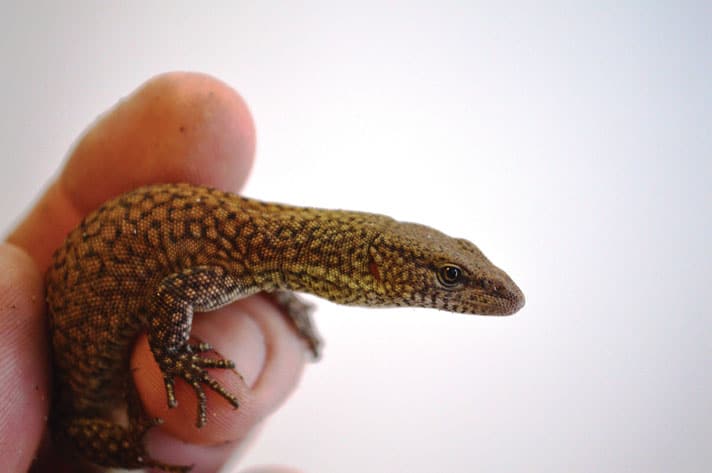The King’s dwarf monitor, though rare, is perfect for monitor lizard fans who lack space.
The Kings’ dwarf monitor (Varanus kingorum) is one of the smallest species of monitor lizard in existence. It’s amazing to think that this tiny lizard belongs to the same genus as the giant Komodo dragon, and while V. komodoensis is the largest lizard in the world, attaining lengths greater than 8 feet, an adult V. kingorum can easily curl up in the palm of your hand!
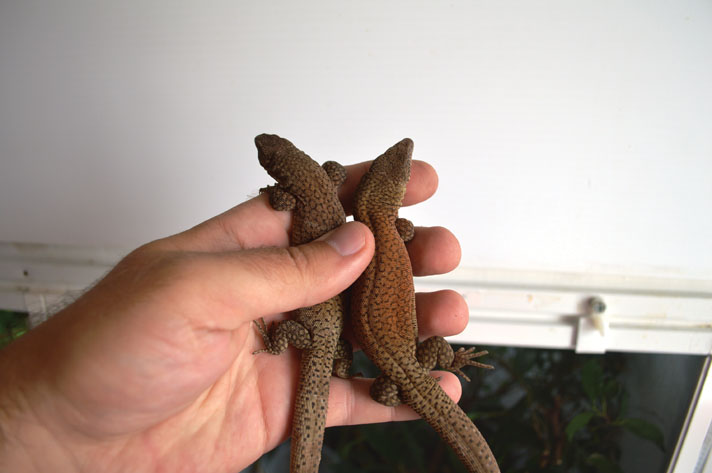
frank j. payne
The King's dwarf monitor is one of the smallest monitor species, rarely exceeding 9 inches.
King’s dwarf monitors are a joy to keep, as they have all of the attractive characteristics of monitor lizards: they’re active, with personality, intelligence and hardiness all in an easily manageable size. While V. acanthurus, or “ackie” monitors, are generally regarded as the best pet monitor due to their smaller-than-most-monitors size, I consider the King’s a close second. The King’s dwarf monitor is smaller than an ackie, and perhaps not as robust, but it’s still hardy and requires much less space and food. It is the perfect pint-sized apartment monitor!
King’s Dwarf Monitor's Are Small And Secretive
The King’s dwarf monitor inhabits a very small range in northwestern Australia, in relatively arid climates, and where it is usually associated with rocky outcroppings.
Very little is known about V. kingorum, which was only recently described in 1980 in its natural habitat. And while it is quite rare and secretive in the wild, luckily, in captivity, King’s dwarf monitors are fairly bold terrarium inhabitants.
Its total length is 7 to 9 inches, with more than half of that being its tail. Coloration is rusty brown and orange with darker reticulations throughout the body. Surprisingly, the leucistic trait is very commonly carried, and most captive V. kingorum are at least heterozygous for leucism. The pale white and peach leucistic animals provide a very interesting contrast to the normally colored lizards.
King’s Dwarf Monitor Care Tips
While King’s dwarf monitors are hardy lizards, they do require fairly specific conditions in which to thrive and breed. Like many Australian monitors, they require lots of heat. I aim for a hot spot of around 120 degrees Fahrenheit. This should not be the temperature of the entire enclosure, remember, but your monitors should have the ability to bask in a hot spot that is maintained at this temperature.
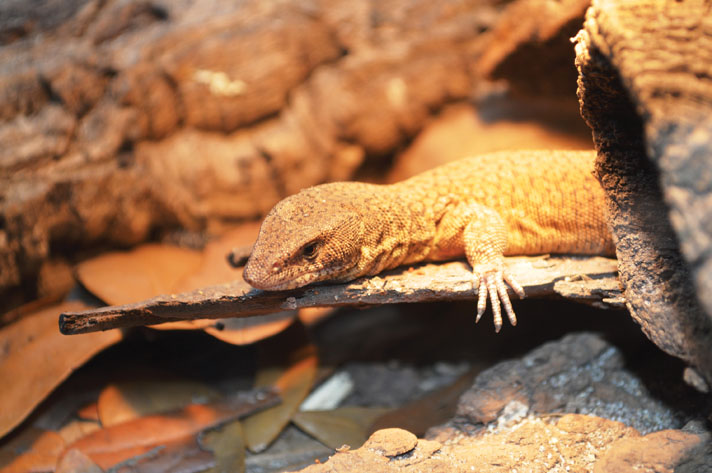
frank j. payne
King’s dwarf monitors like it hot; the author provides his with a hot spot of 120 degrees Fahrenheit.
The best way to provide this high heat is with appropriate basking bulbs. Halogen bulbs are great for this. Because King’s dwarf monitors do best with ultraviolet (UV) light, I use ReptileUV 75 to 100-watt mercury vapor bulbs to provide both heat and UV. Fluorescent UV bulbs work well for light and UV (but not heat; a separate heat source would be needed); for these, I use Zoo Med Reptisun 10.0 and Arcadia 12.0 bulbs.
As when keeping all reptiles, thermoregulation is key. Your monitors should be able to choose their preferred temperature throughout the day, and an easy way to allow for this is to place a heat bulb or two on one side of the enclosure. It’s fine for the cool end to be in the low 80s, and even down to 70 degrees during the cooler months. Nighttime temperatures can drop to normal room temperatures; my animals have been exposed to temperatures as low as 60 degrees during a few winter nights without ill effect.
King's Dwarf Monitor Handling Tips
King’s dwarf monitors are a joy to work with. While they do spend some time hiding, they are out and about throughout the day, and are generally bold around people. They are voracious eaters and will quickly learn to associate you with food, making hand-feeding fun and easy. Some of my more active animals will jump right into the feeding cup or my hand when they see their feeder insects!
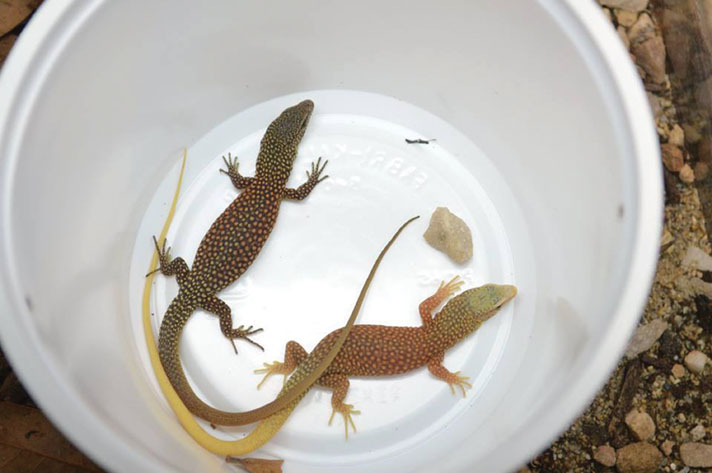
frank j. payne
Check out the long tails on these juveniles.
With some patience, regular short handling sessions are possible. The males especially make great pets. I do not recommend handling breeding females, as this could possibly stress them and causing egg-laying complications
Second in importance to heat is providing your lizards with a sense of security. In nature, King’s dwarf monitors live in rocky crevices, so captive animals need tight hiding places to feel secure.
A tall hide that they can’t feel pressing on their backs will likely lead to stress and an inability to thrive. They prefer closer quarters. I use long, thin slabs of tree bark or cork bark stacked on top of each other. Thin rock such as slate can also be used, but make sure the slabs are firmly anchored and can’t fall on top of any digging or climbing lizards. I provide two to three layers of bark stacked on top of each other, as the multiple layers allow the monitors to choose varying temperature levels within their hiding places. Place the bark in the enclosure lengthwise, from the hot end to the cool end. This will allow your lizards to move from higher temperatures to lower without exposing themselves. Ironically, in my experience, providing numerous secure hiding spots actually results in bolder and ultimately more visible King’s dwarf monitors.
Humidity is another key condition when keeping V. kingorum. Even though they come from an arid region in Australia, their primary microhabitat is much more humid.
I maintain correct humidity by providing a 6-inch-deep layer of an even mixture of potting soil, sand and peat moss. It’s important to keep the soil somewhat damp, but not wet. When using the strong heat lights needed for this species, it’s normal and appropriate for the top layer of soil to dry out quickly as long as the majority of the soil retains some moisture. You want it to stick together without being sopping wet.
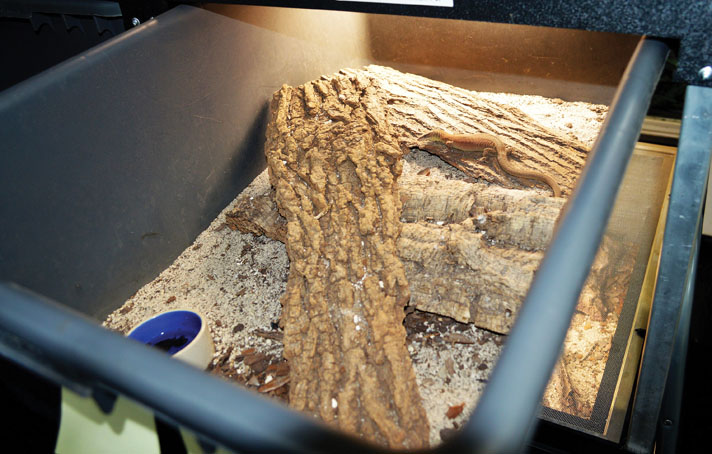
frank j. payne
One of the author’s enclosures, with heat concentrated at one end of the enclosure to allow thermoregulation.
Adding small amounts of water to the soil on a regular basis is a normal part of maintenance. The bark slabs used for hides will trap the humidity from the soil and provide the monitors with humid hides, which will aid in shedding and overall health.
Enclosure size is one of the easiest aspects of keeping King’s dwarf monitors. Babies and juveniles can be kept for months in 10-gallon aquariums, while adult pairs do well in 20-gallon long aquariums or similarly sized enclosures. My adult pairs are kept in enclosures that are 30 inches long by 18 inches wide and 12 inches tall.
Kings’ dwarf monitors are exclusively insectivorous. Fast-moving insects such as crickets and red runner roaches are greatly preferred over slower ones like Dubia roaches and mealworms.
I let feeder insects free roam in the enclosure as the monitors are very adept at finding them in their hiding places. Feeder insects the size of a monitor’s head are preferred over smaller insects. I feed juvenile V. kingorum every day and adults every other day, usually between six and 12 insects per lizard. All insects are dusted with Repashy CalciumPlus supplement. Water is provided by a shallow dish which is changed regularly.
King’s Dwarf Monitor Breeding Tips
Getting King’s dwarf monitors to successfully reproduce is the most challenging aspect of keeping them. I have been successfully doing so for several years now, and I am still learning and experimenting as I go. This is a somewhat rare species in captivity that very few people are currently working with, and we still have a lot to learn.
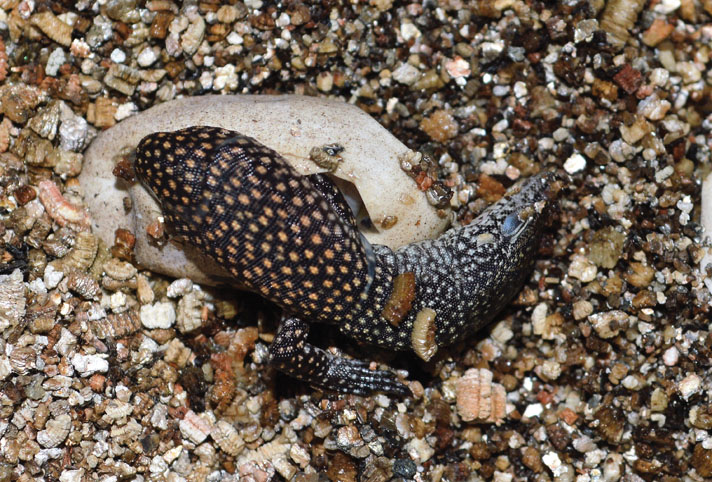
frank j. payne
A normal colored King's dwarf monitor hatchling.
This species grows rapidly and can possibly reach adult size and breed as early as 6 months of age. Breeding at 8 to 10 months is more likely, however. I keep my adults in male-female pairs. Occasionally, I will remove the male for a month or two if it looks like his breeding efforts are preventing the female from getting enough food or being able to bask in peace. Other than that, my pairs seem to coexist peacefully.
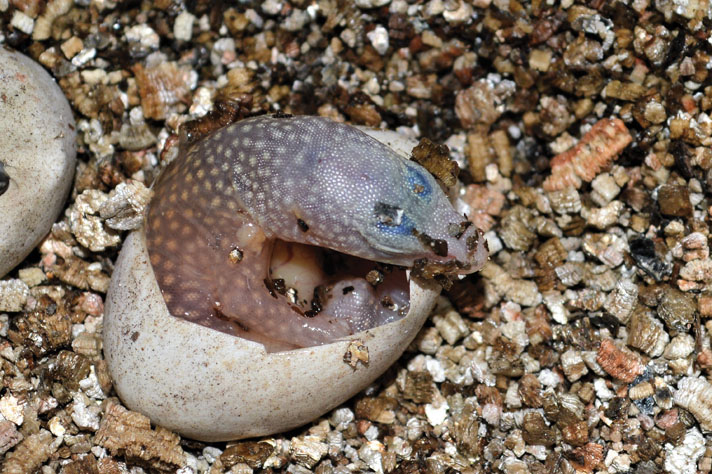
frank j. payne
A leucistic King's dwarf monitor hatchling.
Determining the sex of King’s dwarf monitors can be confusing at first, but once you have seen several adult males and females it becomes obvious. The heads of males are much larger and wider; females’ heads are very narrow and delicate-looking in comparison. My males are always larger and more heavily muscled than the females as well, and the reticulated pattern of the males seems to be more pronounced than that of the females.
The King’s dwarf monitor breeds more like a gecko than a typical monitor, with small clutches of two to four eggs laid at fairly regular intervals. I have read that some females have laid clutches as often as every two weeks, but my females only lay about once every month, and occasionally, a female will go several months without laying.
A gravid female become visibly round and the developing eggs can be easily seen through the thin belly skin. At this time, an appropriate nesting site is of utmost importance. If a female King’s dwarf monitor isn’t happy with her nesting sites, she could possibly retain her eggs and become egg-bound. More frequently, though, an unhappy female will reabsorb her clutch or scatter the eggs on the substrate surface.
I provide my females with a sandy soil substrate of around 6 inches in depth to lay in. They prefer a soil temperature of 82 to 85 degrees. The soil must have some moisture but not be saturated.
Nesting female V. kingorum often dig several test holes when they are nearing the end of gestation. A female may even completely bury herself and disappear from view for a day or two. It is very important to not disturb her during this time.
A female King’s dwarf monitor that has recently laid eggs is very obvious. Whereas she was previously round and smooth, she will look like a deflated balloon after laying because her eggs are quite large compared to her body size. After she has laid, it’s important to make sure she has as many calcium-dusted insects as she wants to eat. A healthy female will rebound back to normal weight within a week of laying.
Young females and new pairs will often take several tries to produce fertile eggs, so don’t get discouraged if your first clutches are infertile.
I incubate my eggs in a 50:50 mixture (by weight) of vermiculite and water in a 16-ounce deli cup. I poke one very tiny hole in the lid of the cup to ensure that pressure doesn’t build up over time. The eggs are incubated at a constant 85 degrees. While other keepers have reported incubation times as short as 90 days, all of my eggs hatch around the 120-day mark.
Hatchling King’s dwarf monitors are actually quite large considering their diminutive adult size. In my experience, if a baby is able to hatch on its own, it will be very hardy. I keep clutchmates together in small terrariums under the same conditions as described previously for the adults. For babies, it is especially important to provide adequate humidity, as I would imagine dehydration could quickly occur at the high temperatures these lizards enjoy.
With daily feedings hatchlings will grow quickly, and they will be approaching adult size at 6 months of age.
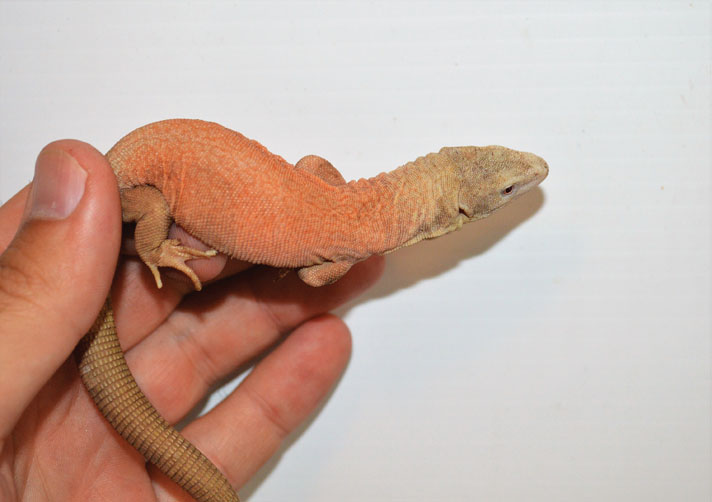
frank j. payne
The peach coloration of leucistic V. kingorum provides an attractive contrast to the normal-colored animals.
At this time, Kings’ dwarf monitors are still very rare, and when they are found, they come with a sizeable price tag. More and more people are having success breeding them in small amounts, however, so hopefully we will see V. kingorum become more common in the hobby.
While they do require some attention to detail, they make rewarding captives and, as mentioned previously, King’s dwarf monitor is a perfect “apartment monitor” for the intermediate keeper who may does not have the space for larger species. The King’s dwarf monitor has become a fun and rewarding project for me, and if you can find some, I can’t recommend them enough.
Frank J. PAYNE is a biology teacher, former senior herpetology keeper and private reptile breeder. He has been keeping and breeding reptiles personally for over 20 years. As a senior AZA herpetology keeper, he worked with more than 100 species of reptiles and amphibians, many of which were threatened or endangered. As a zookeeper, he traveled the country with live animal exhibits, and he often appeared on television shows, including “Late Show with David Letterman.” Visit him online at livingartbyfrankpayne.com.

